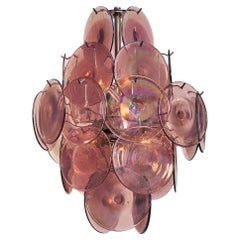Vintage Iridescent Magenta Murano Glass Chandelier
Recent Sales
1990s Italian Chandeliers and Pendants
Amethyst, Steel
Carlo Nason for sale on 1stDibs
A mid-century modern reference for today’s Murano glassmakers, Carlo Nason influenced the current tradition of glassmaking on an island renowned for it for hundreds of years. Celebrated for their exceptional designs, Nason’s lighting fixtures are sought after by collectors worldwide.
Learning to design and craft pieces from the family vetreria — rather than partaking in any formal training — Nason was working with the maestros at his family’s company furnace, V. Nason & C., attached to their family home by the time he was 11 years old. Although his roots are in Murano glassmaking, he took inspiration from the clean lines and natural colors of the Japanese metal vases he had seen in his youth at Milanese fairs.
Wanting to produce modern glass lamps, Nason worked with his family friend Gianni Mazzega of Mazzega Murano. For his Cascata chandelier (Italian for “waterfall”), which debuted in the 1960s, Nason achieved the effect of cascading water through an inverted pyramid of hanging glass plates, each individually mouth-blown and suspended from a chrome-plated frame for a dazzling, Art Deco–styled display.
The 1970s and 1980s were productive and creative years for Nason as the sole and independent designer at Mazzega Murano. His prolific career has also seen him design for other lighting manufacturers like I TRE, Murano Due and Kalmar.
After a mere four years as a glassmaker, Carlo Nason had his creations displayed at the Corning Museum of Glass in New York. The credit for the artisan’s pieces that were included in “Glass 1959” went to his family’s company, but the designs were all authored by Carlo.
Stepping away from the traditional, vibrant Murano stylings, Nason kept true to his inspiration, working with modern and simple forms that are relatively free of color. Nason told Palainco in a rare 2019 interview that his emotions inspired the shapes. And his legacy includes fixtures that are irreplicable and unreproducible, too — Nason made lighting pieces with multiple layers of glass that would be too costly or difficult to recreate today, and some designs were made with processes and materials now unavailable or banned in the glassmaking world.
Find an array of vintage Carlo Nason table lamps, floor lamps, decorative objects and more on 1stDibs.
Finding the Right chandeliers-pendant-lights for You
Chandeliers — simple in form, inspired by candelabras and originally made of wood or iron — first made an appearance in early churches. For those wealthy enough to afford them for their homes in the medieval period, a chandelier's suspended lights likely exuded imminent danger, as lit candles served as the light source for fixtures of the era. Things have thankfully changed since then, and antique and vintage chandeliers and pendant lights are popular in many interiors today.
While gas lighting during the late 18th century represented an upgrade for chandeliers — and gas lamps would long inspire Danish architect and pioneering modernist lighting designer Poul Henningsen — it would eventually be replaced with the familiar electric lighting of today.
The key difference between a pendant light and a chandelier is that a pendant incorporates only a single bulb into its design. Don’t mistake this for simplicity, however. An Art Deco–styled homage to Sputnik from Murano glass artisans Giovanni Dalla Fina (note: there is more than one lighting fixture that shares its name with the iconic mid-century-era satellite — see Gino Sarfatti’s design too), with handcrafted decorative elements supported by a chrome frame, is just one stunning example of the elaborate engineering that can be incorporated into every component of a chandelier.
Chandeliers have evolved over time, but their classic elegance has remained unchanged. Not only will the right chandelier prove impressive in a given room, but it can also offer a certain sense of practicality. These fixtures can easily illuminate an entire space, while their elevated position prevents them from creating glare or straining one’s eyes. Certain materials, like glass, can complement naturally lit settings without stealing the show. Brass, on the other hand, can introduce an alluring, warm glow. While LEDs have earned a bad reputation for their perceived harsh bluish lights and a loss of brightness over their life span, the right design choices can help harness their lighting potential and create the perfect mood. A careful approach to lighting can transform your room into a peaceful and cozy nook, ideal for napping, reading or working.
For midsize spaces, a wall light or sconce can pull the room together and get the lighting job done. Perforated steel rings underneath five bands of handspun aluminum support a rich diffusion of light within Alvar Aalto's Beehive pendant light, but if you’re looking to brighten a more modest room, perhaps a minimalist solution is what you’re after. The mid-century modern furniture designer Charlotte Perriand devised her CP-1 wall lamps in the 1960s, in which a repositioning of sheet-metal plates can redirect light as needed.
The versatility and variability of these lighting staples mean that, when it comes to finding something like the perfect chandelier, you’ll never be left hanging. From the whimsical — like the work of Beau & Bien’s Sylvie Maréchal, frequently inspired by her dreams — to the classic beauty of Paul Ferrante's fixtures, there is a style for every room. With designs for pendant lights and chandeliers across eras, colors and materials, you’ll never run out of options to explore on 1stDibs.
